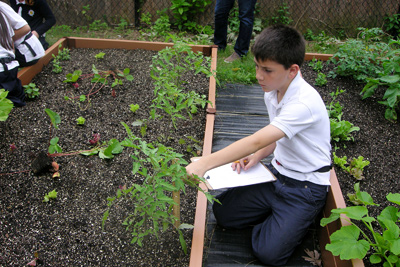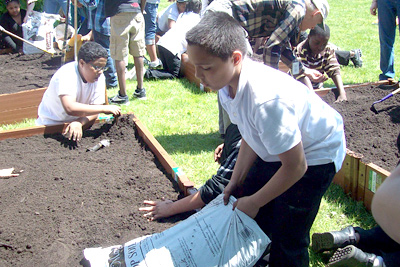Researchers test how school gardens foster healthful habits
By Dani Corona


At 15 low-income schools spread across six New York counties, elementary students are growing fruits and vegetables -- and their minds.
With Cornell's help, the students are participating in the Healthy Gardens, Healthy Youth project, which seeks to encourage young children to eat more fruits and vegetables at school and at home, boost their activity, and enhance their knowledge of nutrition and food systems. Launched in April 2011 in New York, Arkansas, Iowa and Washington with $1 million from the U.S. Department of Agriculture (and with seed funding from Cornell's Atkinson Center for a Sustainable Future and the College of Human Ecology), the project will reach as many as 2,500 students in 50 schools nationwide.
Nancy Wells, associate professor of design and environmental analysis in the College of Human Ecology, who directs the entire project's research and is principal investigator for the New York state efforts, is leading a randomized study to measure the impact of the all the gardens on key outcomes. Nutrition, horticulture and youth development educators at Cornell Cooperative Extension (CCE) and extension counterparts in the participating states are working with the schools on various aspects of the project.
At participating schools, teachers use the gardens as outdoor classrooms, where students learn about math and science amid rows of vegetables. For instance, in one fourth-grade class in Rockland County, students practiced math concepts by measuring the heights of plants and adding up the number of blossoms in the garden.
"It is a rare intervention that has the potential to affect both diet and physical activity," said Wells, an environmental psychologist whose past research has shown nature's positive impact on children's health and cognitive functioning. "What's unusual and exciting about the gardens is that they may be a very potent intervention for childhood obesity, especially because they could affect both sides of the energy-balance equation."
An early challenge for Wells' research team, which includes Cornell undergraduate and graduate students, was determining how to objectively measure students' meals and movement, which will be compared in schools with gardens versus schools without gardens. To solve the problem of measuring food intake, they are analyzing photographs of each child's lunch tray before and after eating.
With funding from the Robert Wood Johnson Foundation's Active Living Research program, the team quantifies physical activity using pedometer-like instruments worn by the children to measure energy expenditure. The researchers also directly observe children's activity in the garden, using a tool developed by Beth Myers, a doctoral student in the field of design and environmental analysis.
In addition, Liz Falk, an extension educator with the Department of Horticulture's Cornell Garden-Based Learning Program, has been actively involved in developing the project's Educational Toolkit that supports classroom and garden learning. Other participating Cornell departments are nutrition, human development and the Cornell Food and Brand Lab.
The study concludes in late 2013.
"Where the pieces come together, where teachers are fully implementing the curriculum and the students have chances to experience the fresh food, it should have an effect," Wells said. "We wanted to study young kids, because we wanted to influence their food choices early to hopefully set them on a trajectory toward a healthier life."
Dani Corona '15 is a student communications assistant for the College of Human Ecology.
Media Contact
Get Cornell news delivered right to your inbox.
Subscribe